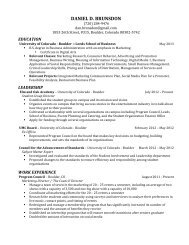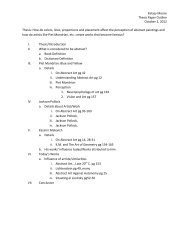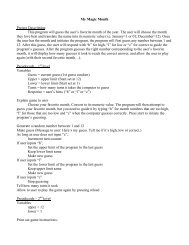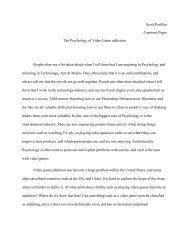- Page 2: Linden Scripting Language Guideby A
- Page 8 and 9: A.193. llSetObjectName ............
- Page 10 and 11: C.20. Vector Constant..............
- Page 12 and 13: Chapter 1. IntroductionThe Linden S
- Page 14 and 15: Chapter 2. Getting Started2.1.2. De
- Page 18 and 19: Chapter 3. BasicsOperatorMeaning/ D
- Page 20 and 21: Chapter 3. Basicsstring StringVar =
- Page 22 and 23: Chapter 3. Basics3.6. Local Variabl
- Page 24 and 25: Chapter 4. Flow Control}string msg;
- Page 26 and 27: 4.3. JumpsChapter 4. Flow ControlA
- Page 28 and 29: Chapter 5. StatesAll scripts must h
- Page 30 and 31: Chapter 5. States}state TimerState{
- Page 32 and 33: Chapter 6. Math6.1. Tables of Funct
- Page 34 and 35: Chapter 8. Lists8.1. Tables of Func
- Page 36 and 37: Chapter 10. Inventory10.1. Tables o
- Page 38 and 39: Chapter 11. VehiclesWhile the follo
- Page 40 and 41: Chapter 11. VehiclesSo a typical Se
- Page 42: Chapter 11. Vehiclesmaximum possibl
- Page 46 and 47: Appendix A. Linden Library Function
- Page 48 and 49: Appendix A. Linden Library Function
- Page 50 and 51: Appendix A. Linden Library Function
- Page 52 and 53: A.30. llDetectedLinkNumberAppendix
- Page 54 and 55: Appendix A. Linden Library Function
- Page 56 and 57: A.49. llGetAgentInfoAppendix A. Lin
- Page 58 and 59: A.59. llGetFreeMemoryAppendix A. Li
- Page 60 and 61: A.69. llGetListLengthAppendix A. Li
- Page 62 and 63: A.79. llGetPermissionsAppendix A. L
- Page 64 and 65: Appendix A. Linden Library Function
- Page 66 and 67:
A.98. llGetTimeOfDayAppendix A. Lin
- Page 68 and 69:
Appendix A. Linden Library Function
- Page 70 and 71:
Appendix A. Linden Library Function
- Page 72 and 73:
A.127. llListenControlAppendix A. L
- Page 74 and 75:
A.135. llMakeFountainAppendix A. Li
- Page 76 and 77:
A.144. llParticleSystemAppendix A.
- Page 78 and 79:
A.153. llReleaseControlsAppendix A.
- Page 80 and 81:
Appendix A. Linden Library Function
- Page 82 and 83:
Appendix A. Linden Library Function
- Page 84 and 85:
A.182. llSensorRepeatAppendix A. Li
- Page 86 and 87:
Critically damps to a height. The h
- Page 88 and 89:
Appendix A. Linden Library Function
- Page 90 and 91:
Appendix A. Linden Library Function
- Page 92 and 93:
Appendix A. Linden Library Function
- Page 94 and 95:
Appendix A. Linden Library Function
- Page 96 and 97:
Appendix A. Linden Library Function
- Page 98 and 99:
Appendix A. Linden Library Function
- Page 100 and 101:
A.241. llWaterAppendix A. Linden Li
- Page 102 and 103:
B.5. collision_endAppendix B. Event
- Page 104 and 105:
Appendix B. EventsThis event is rai
- Page 106 and 107:
B.24. sensorAppendix B. Eventssenso
- Page 108 and 109:
Appendix C. ConstantsTo ease script
- Page 110 and 111:
Appendix C. ConstantsPERMISSION_REM
- Page 112 and 113:
Appendix C. ConstantsATTACH_NOSEAtt
- Page 114 and 115:
Appendix C. ConstantsControl Consta
- Page 116 and 117:
Appendix C. ConstantsAgent Info Con
- Page 118 and 119:
Appendix C. ConstantsPSYS_SRC_PATTE
- Page 120 and 121:
Appendix C. ConstantsDATA_RATINGRet
- Page 122 and 123:
Appendix C. ConstantsVEHICLE_ANGULA
- Page 124 and 125:
C.24. Vehicle TypesAppendix C. Cons
- Page 126 and 127:
Appendix C. Constants| VEHICLE_FLAG
- Page 128 and 129:
Appendix C. Constants// remove thes



 restaurant"
>
restaurant"
>










